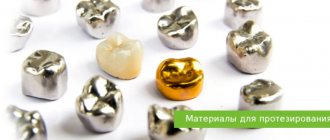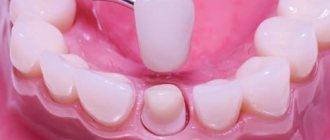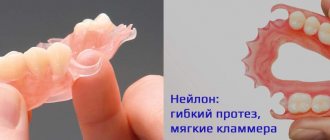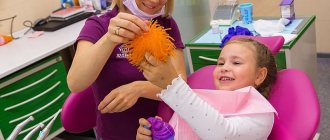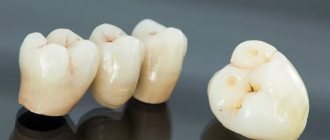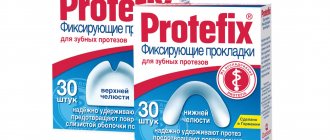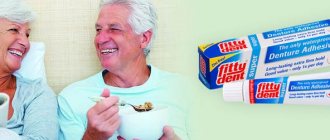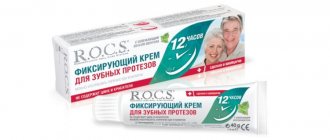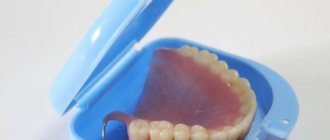581
Thermomolding pressing is considered today the most advanced method of manufacturing dentures.
In this case, polymers based on polymethyl methacrylates are used, which create a rigid base, and polyamides (nylons), with which flexible bases are obtained.
Unlike chemically cured polymers, thermoplastics do not contain allergenic monomers that irritate the mucous membrane.
About the manufacturer
The Israeli dental company Perflex LTD specializes in the production of thermoplastic polymers for the manufacture of dentures. Its product range also includes instruments, components and materials for dental laboratories.
The company was founded in 2007. This was preceded by a long period of research, development and improvement of thermoplastic materials used in dental prosthetics.
Perflex materials are used in 129 countries around the world. The company's representative office in Russia (Perflex RUS) with an office in St. Petersburg was opened in February 2013. All Perflex LTD products comply with international standards.
Advantages
The products are manufactured by an Israeli brand that produces high-quality materials for dentures. Perflex is popular all over the world; today the thermoplastic is in demand by dentists in 129 countries, meeting the requirements for reliability and safety.
The materials differ in composition, which lacks monomers. This eliminates the risk of allergic reactions and tissue injury. In addition, Perflex has the following advantages:
- high aesthetics of the surface of the prostheses, the presence of a rich palette of shades to obtain the most natural appearance;
- the design can be used together with other types of materials, already installed ceramic or porcelain crowns;
- the manufacturability of the structures is not inferior to acrylic, the polishability of the surface is excellent;
- dentures can be repaired, chips and cracks can be eliminated, which reduces the cost of restoring the functionality and appearance of the row;
- hypoallergenic, biologically compatible, installed products do not cause complications or the development of inflammatory reactions.
Advantages of materials
A special feature of materials for thermomolding is the absence of monomers, which are used for cross-linking during chemical curing.
Perflex monomer-free plastics have the following advantages:
- Biocompatibility and hypoallergenic due to the absence of monomers. Hypoallergenic thermoplastic materials are ideal for patients with hypersensitivity to various chemicals.
- High strength. Allows the production of compact, thin bases without a metal frame, which ensures high aesthetics and quick adaptation to prostheses.
- Maintainability. Dentures made from Perflex materials can be easily repaired and upgraded using thermoplastic and chemically curing polymers, adding teeth, clasps and other structural elements.
- High technology. The machinability and polishability of most Perflex materials is on par with acrylic plastics. Even materials for flexible bases (Flexinylon, for example) have quite good polishability.
- Can be used in combination with ceramics and other materials, including porcelain teeth.
- High aesthetics due to a variety of colors and the ability to produce polymer clasps that have low visibility compared to metal ones.
In general, Pereflex materials meet all the basic requirements for this class of materials and have the best characteristics to date.
Does a universal false jaw solve the problem of missing teeth and is it worth buying?
Come here to find out how dentures affect the microflora of the oral cavity.
At this address https://www.vash-dentist.ru/protezirovanie/semnyie-p/akrilovyih-ivocap.html all about Ivocap removable dentures.
Possible complications when wearing removable dentures
As a rule, adaptation to removable dentures occurs in most patients without pronounced complications. Adaptation takes about 2 weeks. However, there are cases when deviations from the norm are possible. Their causes can be either the individual characteristics of the patient’s body, or an error in choosing the type of prosthesis, incorrect installation or manufacturing of the structure, failure to maintain oral hygiene, or a change in bite.
The most common complications include:
- Rubbing in the mouth. They are accompanied by unpleasant sensations when chewing, pain or increased salivation. It is necessary to consult a doctor so that he can correct the prosthesis, sometimes this is done 2 times.
— Denture stomatitis is an inflammatory process of the oral mucosa. It occurs due to pressure and friction of the prosthesis on soft tissues. It happens that the elements of the prosthesis irritate the tissue, which also causes inflammation. A doctor can eliminate this phenomenon by antiseptic treatment of the mouth and denture. The patient is recommended to rinse, take baths, and apply tampons with ointment.
— Diseases of supporting teeth – natural teeth present in the oral cavity may also require treatment sooner or later. Signs that it is time to visit a doctor include: pain at night, during meals, bad breath or bad breath from the prosthesis, bleeding.
— Allergic reactions – contact of the body’s mucosa with prosthetic materials causes tissue irritation in some patients. It manifests itself with various symptoms: rashes on the skin of the face, redness in the mouth, inflammation of the salivary glands, burning, suffocation.
- Galvanic syndrome - the formation of a galvanic current is possible in the presence of various materials in the mouth that come into contact with saliva: steel, silver, cobalt-chrome and other alloys. In this case, the patient may feel a metallic taste in the mouth, bitterness, general malaise, and headache. In case of pronounced symptoms, repeated prosthetics with homogeneous materials is indicated.
— The dental bridge may come off due to prolonged use or too much pressure during chewing.
Varieties
The Pereflex line of thermoplastic materials provides the production of dentures of all types - removable and fixed, full and partial, clasp and plate.
Thermoplastics are supplied in 2 forms:
- In the form of granules for thermomolding , filled into cartridges or placed in small containers for self-filling of cartridges.
- In the form of hard disks intended for the manufacture of prosthetic elements by milling using CAD/CAM technology.
A variety of colors allows you to obtain the optimal color of the prosthesis. Below are the types and characteristics of the main brands of Perflex LTD thermoplastics.
T-crystal
Thermoplastic monomer-free polymer. Used to make mini dentures, full dentures, partial dentures and dentures.
It has strength and elasticity, allowing you to do without a metal frame. Thanks to this, the prosthesis can be made thinner and less expensive (the process of metal casting is eliminated).
It is produced in the form of granules, packaged in polyethylene jars and filled into cartridges. Available in 5 colors – light pink, pink, transparent, purple-pink, opaque pink.
Biosense
The material is intended for the manufacture of all types of removable dentures. Available in two forms - granules and disks (Biosense CAD/CAM).
The granules have 8 colors - light pink, pink, transparent, violet-pink, opaque pink, light pink, pink-transparent, violet-pink, light.
Discs with a diameter of 98 mm and a thickness of 16, 20 and 24 mm are available in 2 colors - transparent and pink.
Biosense prostheses are strong enough to be made without a metal frame. The material has moderate flexibility, good machinability and polishability. Combination with other materials is possible.
Acryfree
The material is intended for the manufacture of prostheses of all types, including those on implants. The most important features include resistance to breakage, long service life, and low weight.
If a breakdown does occur, the prosthesis can be successfully repaired with polymers of both hot and cold polymerization.
Acryfree polishes perfectly, acquiring a beautiful shine. Can be used in combination with ceramic teeth.
Release form - granules of 8 colors: light pink, pink, transparent, violet-pink, opaque pink, light pink opaque, opaque pink No. 5, violet-pink light.
Flexinylon
Refers to materials that are used to obtain bases that are flexible but maintain sufficient stability. Used in the manufacture of standard and mini-prostheses, night guards.
It has stable color and low water absorption. Unlike standard nylon dentures, it is well polished (to a shine).
Low visibility and moderate flexibility make Flexinylon prostheses physically and psychologically comfortable for the patient.
Flexinylon can be used as a repair material for dentures made from other thermoplastics.
Presented in granules of 4 colors - light pink, pink, colorless, violet-pink, light red.
Acetal
The polymer is intended for the manufacture of removable and fixed dentures, night guards, bridges, clasps, crowns and other types of orthopedic structures, both in combination with a metal frame and without it.
It has high impact and abrasion resistance, low water absorption, easy polishability, and color stability. Durable and comfortable for the patient.
Available in the form of granules and disks (Acetal CAD/CAM) for CAD/CAM technology. The color options for granules are A2, AZ, AZ.5, A4 on the Vita scale and pink. Acetal perfectly imitates the color of natural teeth.
Disc sizes – Ø 98.5 mm, thickness 16, 20 and 24 mm. Color – A1, A2, AZ, B1, B2, C1, OM1 according to Vita jackal.
PureP
Clean, transparent and durable material. Intended for use as an intermediate element between infrastructures and cladding of orthopedic structures. The density and elasticity of the material is similar to natural bone.
Frames, bridges, crowns mounted on cement and without metal are made from PureP. As well as superstructures of implant systems - abutments, caps, restorations.
PureP elements are veneered with composite veneers, which can be removed or repaired without affecting the cemented super element.
The purity of the material allows it to be in long-term or constant contact with the mucous membrane without causing irritation. Light weight and translucency ensures full compliance with natural teeth.
Available in granules and discs (PureP CAD/CAM). The granules are packaged in jars of 50 and 100 g. Milling discs have a diameter of 98.5 mm, thickness 16, 20 and 24 mm.
Thermofix
Thermofix is an impression material used for taking impressions of jaws, making custom trays or modifying standard trays to suit individual jaw sizes.
Thermofix is used to register bites and produce night guards and whitening trays.
The material is easy to use and easy to shape. Has a color indication of readiness for working condition (white granules placed in hot water become transparent when the material becomes ready for molding).
Thermofix is available in 4 colors - white, blue, pink and yellow.
Types of removable dentures
The choice of dentures is made together with the attending physician, based on the patient’s existing medical indications. The dentist is obliged to show design options and tell in detail about each of them. Removable dentures are divided into types depending on the number of teeth lost.
Denture "butterfly"
Designed to restore the dentition when one or more units are lost. The prosthesis is fixed using clasps (special brackets) on the molars adjacent to the defect. In appearance, the prosthesis resembles a butterfly, which is why it received the appropriate name. It completely performs the functions of a missing tooth.
Main advantages:
- aesthetically corrects an area with one missing front tooth;
- allows you to get rid of discomfort when chewing and evenly distribute the load on the entire jaw;
- Helps prevent teeth shifting and avoid problems with poor diction.
From an orthopedic point of view, a prosthesis of this type allows you to maintain a normal bite and prevent a decrease in the volume of bone tissue until a permanent implant is placed.
Silicone denture
Silicone dentures are known to be durable and comfortable to wear. They do not require a long time of getting used to and adapting and are suitable for the upper and lower jaw. The service life is 5 years. The main advantages of the design are:
- elasticity and flexibility, which prevents injury to soft tissues;
- excellent fixation to the upper palate;
- comfort of use - no risk of rubbing or squeezing;
- color constancy upon contact with food dyes;
- high strength of the material;
- hypoallergenic;
- no need to grind healthy teeth for installation.
Partial removable dentures
These designs are used when there are not several teeth in a row in a row. They are recommended for those patients who are unable, financially or for medical reasons, to install an implant or bridge. Special hook-shaped parts serve as fastening.
Partial removable dentures are:
- Lamellar - they are placed when the main chewing teeth are lost or 2-3 units in a row.
- Segmental - used to replace a separate sector (section) or for unilateral tooth loss.
- Immediate prostheses are replacement structures for temporary use; are applied to the gaps in the row until the permanent prosthesis is installed.
- Bugel - structures on a durable metal arc frame, allowing you to evenly distribute the load when chewing food.
All of the listed prostheses are made from modern, laboratory-tested and hypoallergenic materials. They are well tolerated by patients and quite comfortable to wear.
Dentures for complete absence of teeth
Removable dentures are used when the patient is missing all teeth in the oral cavity. Such prostheses do not have special fastenings, and they are fixed by suction. Various polymers are used as materials for the manufacture of structures, which do not cause allergies and are able to replicate the anatomical features of the jaw. Removable dentures serve as a preventive measure against bone tissue atrophy and allow the load to be distributed evenly.
There are two types of designs:
- Removable implant-supported – 2-4 basic implants are placed in the oral cavity, which turn out to be a kind of “foundation” for the entire structure. It is secured using ball locks or rectangular rods.
- Fixed – indicated for complete or overwhelming absence of teeth. Installation and removal can only be performed by a doctor.
When choosing the type of removable dentures, consultation with a specialist is necessary. The structures are made individually, which ensures wearing comfort, perfect fit, distribution of chewing load and preservation of bone health.
New generation dentures
They are similar to traditional ones, but they do not have a sky. The structure is fixed to the supporting teeth using hinges, telescopic fasteners or locks (hinges).
Instructions for use
The production of prostheses from Perflex thermoplastic materials is carried out using standard thermomolding pressing technology. Its essence is that a molten polymer is pressurized into a plastered model, which, after cooling, takes the desired shape.
To immediately begin thermomolding pressing, you must have:
- an assembled cuvette containing the model form.
- cartridge with polymer granules;
- heat press (injection oven) for heating and pressing the polymer into a mold.
The main, most important and time-consuming operation is modeling the prosthesis and assembling the cuvette. As for the actual wax modeling and plastering of the cuvette, they are performed according to a standard protocol.
The following operations are carried out in the following sequence:
- The plastered cuvette with the wax model is placed in a container and poured with boiling water to soften the wax. After waiting for 5-8 minutes, the cuvette is separated, the softened wax is removed, and its remains are washed off with hot water.
- The acrylic teeth are taken out and holes are drilled into them for retention. Glue the drilled teeth to the plaster bed.
- Assemble the cuvette. Now there is a cavity inside it, surrounded on all sides by plaster and the metal walls of the cuvette. The configuration of this cavity exactly matches the shape of the prosthesis.
The thermomolding operation itself is performed as follows:
- The polymer cartridge is installed in a heat press (injection oven), and the heating mode is turned on to 280°-300°.
- A cuvette with a mold is installed at the output end of the cartridge.
- After warming up the cartridge and cuvette (after about 18-20 minutes), the polymer input button is pressed at the timer signal. In this case, the press cylinder squeezes the heated mixture from the cartridge into a cuvette with a mold.
- The pressure is maintained for 5 minutes with the heat turned off.
- The cuvette is removed from the heat press and left at room temperature to cool and become slightly warm.
- The cuvette is disassembled and the prosthesis is removed.
- The prosthesis is grinded and polished.
Thermomolding technology may vary depending on the equipment used. In any case, pressing must be carried out strictly according to the instructions for the equipment used.
For what purpose are obturators installed for defects of the hard and soft palate, and what functions are assigned to them?
In this publication, we will look at the pros and cons of dentures without a palate in the case of partial absence of teeth.
Here https://www.vash-dentist.ru/protezirovanie/semnyie-p/kak-ne-dopustit-allergii-na-zubnyie.html we’ll talk about the tactics of treating allergies to dentures.
What is a removable denture?
Prosthetics of this type are recommended for patients suffering from complete or partial absence of teeth. If necessary, a person can independently remove and install the structure, without the help of a dentist. Dentures are easy to care for, although they require high-quality hygienic treatment. The reasons for the popularity and demand, as well as the advantages of removable dentures include:
- accessible restoration of the dentition in terms of aesthetics and chewing function, which prevents the destruction of bone tissue;
- the designs are universal in design and can be used for both partial and complete loss of teeth;
- all prostheses are prepared taking into account the individual anatomical parameters of the patient;
- long service life, ease of use and resistance to mechanical damage;
- lack of conditions for bacterial growth;
- short adaptation period, easy installation;
- Possibility of removal before bedtime;
- lower cost compared to implantation.
Before installing dentures, it is necessary to undergo a thorough examination by a dentist, and if periodontal diseases and caries are detected, they must be treated. It is recommended to get rid of sick and loose teeth and carry out professional hygienic cleaning, which will help remove stones and plaque. These procedures reduce the risk of developing inflammation when wearing a prosthesis.
Helpful Tips and Warnings
The use of Pereflex materials does not have any special differences from the use of thermoplastics from other manufacturers, and does not present any difficulties for the dental technician.
All technological details are contained in the instructions for the specific brand. The most important points affecting the quality of the future structure include plastering of models, which is recommended to be done with class 3 supergypsum.
Material of the 2nd class may not withstand pressure, and the 4th class can create difficulties when removing from the mold.
Plastering should be done on a vibrating table to eliminate air cavities. When calculating the amount of thermoplastic, you need to take into account the volume of the sprues.
After removing the wax from the plaster model, you must remember to lubricate the walls with the last heat-resistant lubricant to prevent the prosthesis from adhering too tightly to the plaster.
When using polymethylacrylates (for a hard base) on artificial teeth, one hole is sufficient as a retention point. When making flexible bases, several holes + a circular groove are made on the teeth.
In the video, watch the process of making a removable denture from Perflex Acetal.
Removable partial denture Acry Free
To produce partial dentures from Acree Free for our patients, we use material from a German company. In the dental laboratory, Acri Free dentures are produced by thermal pressing, which are characterized by increased strength and at the same time softness. They combine the advantages of acrylic and nylon products. The Acry Free material from which such structures are made does not contain free monomer, which is present in acrylic. There are several significant differences between acrylic-free prostheses and nylon and acrylic products:
- easy to restore and correct;
- longer service life;
- hypoallergenic (due to the absence of free monomer);
- comfortable and easy to wear;
- lighter, thinner, have a natural appearance;
- translucent base, imitation of natural gum.
One of the most important advantages of dentures from Acree Free is the ability to weld the missing crown; if adjacent teeth are lost, our specialist will be able to adjust the denture. The minimal porosity of Acry Free products allows them to remain smooth and retain their original color; they do not absorb dyes from drinks or food.
The elasticity of Akri Free dentures ensures uniform distribution of the chewing load, which avoids deformation of the gums and supporting teeth. Acry Free partial removable dentures are manufactured to replace teeth in quantities of 4 units and have fastenings - clasps. The cost is RUB 49,450.00.
Reviews
Dentists usually do not inform patients from what materials the elements of their prosthesis are made. And this is understandable, in order to receive a quality service, there is no need to be informed in all its intricacies.
If you do know that your prosthesis was made from Pereflex thermoplastics, tell us how high quality and comfortable it was. Comments can be left at the bottom of the page.
If you find an error, please select a piece of text and press Ctrl+Enter.
Tags dentures removable dentures
Did you like the article? stay tuned
Previous article
Alvostaz sponge - hemostatic and antiseptic compress
Next article
Which dentures are considered best: removable or fixed?
